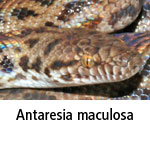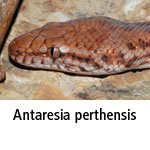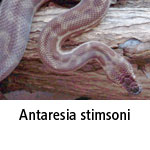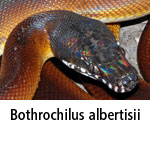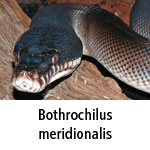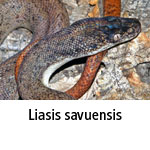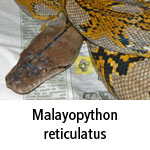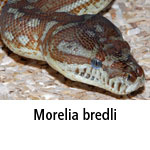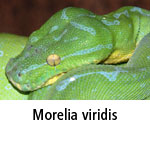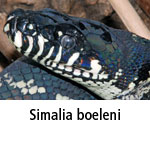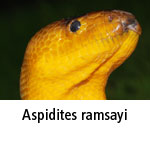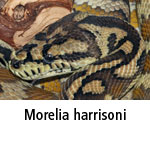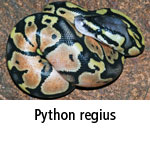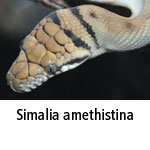
Pythonidae – Pythons
There has been a lot of changes in the systematic of snakes recently, also affecting the formerly so-called giant snakes. Until 2010 the pythons together with boas and sand boas were considered a part of the Boidae family and colloquially summarized as "giant snakes". Since then the pythons have become a separate family with several genera of which seven are currently recognized:
Python (true pythons)
Malayopython
Morelia (scrub pythons)
Antaresia (dwarf pythons)
Liasis (water pythons)
Aspidites (black-headed pythons)
Bothrochilus (white-lipped pythons)
Pythons are invariably egg-layers (oviparous). They live in different habitats from rainforest to dry, sandy areas. Some species are bonded to the substrate, others are perfect climbers.
In principle pythons are well suited as terrarium animals. Among them there are dwarfs of less than one metre in length, many medium-sized species and some giants, who are among the "Big Five". These include the following species, four pythons and one boa:
Python (true pythons)
Malayopython
Morelia (scrub pythons)
Antaresia (dwarf pythons)
Liasis (water pythons)
Aspidites (black-headed pythons)
Bothrochilus (white-lipped pythons)
Pythons are invariably egg-layers (oviparous). They live in different habitats from rainforest to dry, sandy areas. Some species are bonded to the substrate, others are perfect climbers.
In principle pythons are well suited as terrarium animals. Among them there are dwarfs of less than one metre in length, many medium-sized species and some giants, who are among the "Big Five". These include the following species, four pythons and one boa:
- Burmese Python (Python bivittatus)
- Rock Python (Python sebae)
- Reticulated Python (Malayopython reticulatus)
- Australian Amethystine Python (Simalia kinghorni)
- Great/Green Anakonda (Eunectes murinus)
Pythonidae – Pythons
In der Systematik der Schlangen ist seit einigen Jahren viel Bewegung, die auch die früher als "Riesenschlangen" zusammengefasste Gruppe betrifft. Wurden die Pythons bis 2010 gemeinsam mit Boas und Sandboas als ein Bestandteil der Familie Boidae betrachtet, so werden sie seitdem als selbstständige Familie mit einigen Unterfamilien von den Boas getrennt gesehen. Folgende Gattungen sind zurzeit anerkannt:
Python (Eigentliche Pythons)
Malayopython
Morelia (Rautenpythons)
Antaresia (Südpythons)
Liasis (Wasserpythons)
Aspidites (Schwarzkopfpythons)
Bothrochilus (Weißlippenpythons)
Pythons sind ohne Ausnahme eierlegend (ovipar). Sie leben in unterschiedlichsten Habitaten von Regenwald bis zu trockenen und sandigen Gebieten. Einige Arten sind an den Untergrund gebunden, andere perfekte Kletterer.
Prinzipiell sind Pythons gut als Terrarientiere geeignet. Unter ihnen gibt es Zwerge von unter einem Meter Länge, viele mittelgroße Arten und einige Riesen, die zu den "Big Five" zählen. Zu diesen gehören folgende Arten, darunter vier Pythons und eine Boa:
Python (Eigentliche Pythons)
Malayopython
Morelia (Rautenpythons)
Antaresia (Südpythons)
Liasis (Wasserpythons)
Aspidites (Schwarzkopfpythons)
Bothrochilus (Weißlippenpythons)
Pythons sind ohne Ausnahme eierlegend (ovipar). Sie leben in unterschiedlichsten Habitaten von Regenwald bis zu trockenen und sandigen Gebieten. Einige Arten sind an den Untergrund gebunden, andere perfekte Kletterer.
Prinzipiell sind Pythons gut als Terrarientiere geeignet. Unter ihnen gibt es Zwerge von unter einem Meter Länge, viele mittelgroße Arten und einige Riesen, die zu den "Big Five" zählen. Zu diesen gehören folgende Arten, darunter vier Pythons und eine Boa:
- Dunkler Tigerpython (Python bivittatus)
- Felsenpython (Python sebae)
- Netzpython (Malayopython reticulatus)
- Australischer Amethystpython (Simalia kinghorni)
- Grüne/Große Anakonda (Eunectes murinus)
Literature / Literatur
Akeret, B. (2008): Gefahrenpotenzial Riesenschlangen. Reptilia 13 (4): 4–12. NTV, Münster.
Akeret, B. (2008): Gefahrenpotenzial Riesenschlangen. Reptilia 13 (4): 4–12. NTV, Münster.
Under preparation • In Vorbereitung
